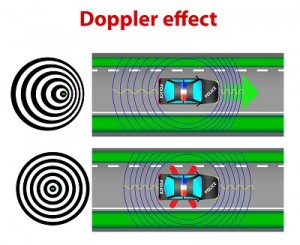When a wave travels from one medium to another, like sound waves traveling in the air and then through a glass window pane, it crosses a boundary. Whether the wave continues to the new medium (and even how it goes through), or whether it bounces and reflects back, or a bit of both depends on the boundary.
Please login or register to read the rest of this content.
Straight waves are what happens when something moves back and forth in a medium like water. These are interesting when they hit a diagonal plane barrier, because when the incident wave reaches the barrier, the waves always reflect at the same angle that they approached the barrier with (called the Law of Reflection).
Please login or register to read the rest of this content.
Waves bend when they go from one medium to another when the speed changes. It’s a really important topic in light (not so much with sound), because it’s how lenses, eyes, cameras, and telescopes work. The bending of sound waves happens naturally in the air above the earth when it’s warmer than the surface of the earth. The sound waves that travel through the warmer air are faster and the ones that travel through cooler air are slower. When the sound waves go from warmer to cooler air (less dense to more dense air), they become bent back down toward the surface.
Please login or register to read the rest of this content.
When waves pass around small (we’re talking small compared to the wavelength of the wave) objects, they diffract. People in the audience of a concert can hear really well if they are sitting right behind a pillar because the sound waves are large enough to bend around it (which is actually because of both diffraction and reflection effects). Diffraction helps sound bend around obstacles. You can sometimes hear conversations around corners because of diffraction.
Please login or register to read the rest of this content.
Often two (or more) waves travel through the same spot. If you’ve ever listened to an orchestra, you’re hearing the sounds from many different instruments all playing at the same time. If more than two boats are on the lake, their wakes churn up the water together. Here’s how we handle this in physics…
Please login or register to read the rest of this content.
What if two waves of the same wavelength and amplitude travel in the same direction along a stretched string? What will the string look like? We know about the idea of superposition adding the waves together, but what does the string actually look like?
Please login or register to read the rest of this content.
 Imagine a police car on the side of the road with lights and sirens on full blast. You’re also parked and you hear the same frequency (say 1,000 Hertz) of the siren. However, if you’re driving at 75 mph toward the police car. you’re going to hear a higher frequency (1096 Hz), and if you’re driving away at 75 mph, you’re going to hear a lower frequency of 904 Hz. Why is that?
Imagine a police car on the side of the road with lights and sirens on full blast. You’re also parked and you hear the same frequency (say 1,000 Hertz) of the siren. However, if you’re driving at 75 mph toward the police car. you’re going to hear a higher frequency (1096 Hz), and if you’re driving away at 75 mph, you’re going to hear a lower frequency of 904 Hz. Why is that?
Please login or register to read the rest of this content.
